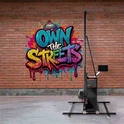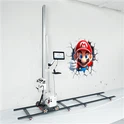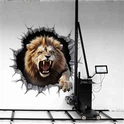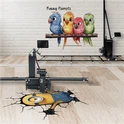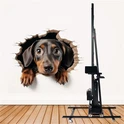Struggling with wall prints that smudge, fade, or fail to stick on tricky surfaces like textured brick or glossy tile? UV ink solves these headaches, delivering vibrant, durable murals that cure instantly and grip almost any wall. From painted drywall to outdoor concrete, UV ink ensures consistent colors and fewer costly redos. Industry leaders report over 80% of modern wall printers rely on UV technology, making it the go-to for pros and creatives alike. In this guide, we'll break down how UV ink works, its unmatched benefits, real-world applications, and how to choose the right wall printer to elevate your projects. Ready to transform your wall printing game? Let's dive in.
What Is UV Ink and How Does It Work?
UV ink is a game-changer for wall printing. It's a liquid mix of pigments, monomers, oligomers, and photoinitiators that hardens instantly under ultraviolet (UV) light. Unlike traditional inks that dry through evaporation, UV ink polymerizes-turning from liquid
to a solid film in under 2 seconds when exposed to UV rays. This process, called curing, ensures prints stick fast and stay vibrant.
How It Works in Wall Printers
Wall printers, like Tanyu UV models, jet ink onto surfaces while integrated LED UV lamps cure it instantly. The process:
1. Ink is sprayed via precision inkjet heads.
2. UV light hits photoinitiators, triggering a chemical reaction.
3. Monomers and oligomers crosslink, forming a durable print.
This instant curing eliminates drips or smudges, perfect for vertical surfaces like walls or glass. UV's solvent-free formula also cuts energy use by up to 40% compared to older systems.
Why It Matters
UV ink's speed and adhesion make it ideal for diverse substrates, from plaster to metal, driving its dominance in 2025 wall printing. Next, let's explore why it outperforms other inks.
Key Benefits of UV Ink for Wall Printing
UV ink stands out for its durability, efficiency, and versatility. Here's why it's the top choice for most wall printers.
1. Unmatched Durability
Once cured, UV wall prints resist scratches and fading, lasting 5–10 years indoors or outdoors with proper topcoats. This durability reduces reprints, saving time and building client trust.
2. Lightning-Fast Curing
UV ink hardens in seconds under LED lamps, enabling print speeds up to 6m²/hour. This cuts project times by up to 50%, letting you handle more jobs and boost profits.
3. Versatile Adhesion
UV ink sticks to nearly anything:
- Porous surfaces: Painted drywall, sealed wood, or primed brick.
- Non-porous materials: Glass, tile, or metal with adhesion promoters. It reduces waste by 30% compared to solvent inks, making it eco-friendly and cost-effective.
4. Eco-Friendly Edge
Low volatile organic compounds (VOCs) mean safer workspaces and greener projects, aligning with 2025 sustainability demands.
These benefits make UV ink a no-brainer for wall printing. But how does it stack up against other inks?
UV Ink vs. Traditional Inks: A Clear Winner
UV ink outperforms aqueous, solvent, and latex inks for wall printing. Here's a detailed comparison to help you choose.
| Factor | UV Ink | Aqueous (Water-Based) | Solvent/Eco-Solvent | Latex |
|---|---|---|---|---|
| Color Gamut | Wide, vibrant | Good on coated media | Wide, strong on vinyl | Good to wide |
| Curing/Dry Time | Instant under UV | Slow; needs evaporation | Moderate; needs outgassing | Fast; heat-assisted |
| Adhesion (Porous) | Strong, primer optional | Soaks; needs primer | Good with prep | Good with primer |
| Adhesion (Non-Porous) | Strong with primer | Weak | Good on films | Variable; needs prep |
| Durability | High; scratch-resistant | Low–moderate | Moderate | Moderate–good |
| Odor/VOCs | Low odor; low VOC | Very low | Noticeable | Low |
| Environmental Needs | UV safety, ventilation | Drying airflow | Ventilation | Heat, airflow |
| Cost of Ownership | Moderate; high uptime | Low ink cost; limited use | Moderate; ventilation | Moderate; heater energy |
Why UV Wins
- Speed: Instant curing eliminates drying delays, unlike aqueous (hours) or solvent (moderate outgassing).
- Versatility: UV ink adheres to more surfaces with less prep.
- Eco-Advantage: Low VOCs reduce health risks compared to solvent inks.
Traditional inks fade faster and struggle with non-porous surfaces, while UV ink delivers consistent results. Next, let's see where UV ink shines in real-world use.
Real-World Applications of UV Wall Printing
UV ink's versatility powers a wide range of projects, from commercial to residential. Here are key use cases and a success story.
B2B Applications
- Hospitality: Branded murals, wayfinding graphics for hotels.
- Retail: Eye-catching feature walls to boost store appeal.
- Education/Healthcare: School mascots or donor recognition walls.
B2C Applications
- Home Decor: Custom murals for kids' rooms or rental-friendly graphics on primed walls.
- Typography Art: Personalized quotes or designs on diverse surfaces.
Case Study: Hotel Lobby Transformation (Assumed)
A U.S. printing company used auv wall printer to create a 100 m² lobby mural on textured plaster. With a white ink underbase and clear topcoat, the vibrant design lasted over 5 years with no fading. The project, completed in 12 hours, earned $8/m² profit, showcasing UV's speed and durability.
These examples highlight UV ink's flexibility. Let's explore how to achieve these results.
How to Use UV Ink for Wall Printing: Step-by-Step
Achieving flawless UV prints requires proper prep and execution. Follow these steps for success.
1. Surface Prep
- Clean walls to remove dust/oils.
- For porous surfaces (brick, concrete), apply a masonry primer.
- For non-porous surfaces (glass, tile), use special coating.
- Check moisture (below 10%) and pH (neutral) to avoid curing issues.
2. Wall Printer Setup
- Calibrate inkjet heads for even laydown.
- Ensure LED UV lamps are compatible with your ink (check wavelength).
- Load CMYK + white/varnish for dark or textured walls.
3. Printing and Curing
- Print in passes, adjusting for texture or coverage needs.
- Cure instantly with UV lamps; verify adhesion with a tape test after 24 hours.
4. Finishing
- Apply a clear topcoat for outdoor durability or gloss effects.
Pro Tip: Test small patches on actual substrates to confirm adhesion before full-scale printing.
With these steps, you're set for success. But what mistakes should you avoid?
Common Mistakes and How to Avoid Them
Even pros can trip up with uv wall printing. Here's a checklist to dodge common pitfalls.
- Skipping Surface Prep
Mistake: Printing on dirty or damp walls leads to poor adhesion. Fix: Clean thoroughly, check moisture, and use primers for glossy/porous surfaces.
- Under- or Over-Curing
Mistake: Incorrect lamp power or speed causes tacky or brittle prints. Fix: Match lamp settings to ink/substrate; run strip tests to confirm cure.
- Overusing White Ink
Mistake: Excessive white underbase spikes costs without adding value. Fix: Use white only on dark/textured walls; optimize via software settings.
- Ignoring Ventilation
Mistake: Poor airflow causes odor buildup or health risks. Fix: Use portable air scrubbers and follow SDS for safe handling.
- Printing on Unstable Surfaces
Mistake: Chalking paint or curing plaster ruins prints. Fix: Seal surfaces and wait for full substrate curing.
Avoiding these errors ensures quality and efficiency. Next, let's calculate costs to understand UV's value.
Cost Breakdown and ROI for UV Wall Printing
UV wall printing balances upfront costs with long-term savings. Here's an estimated cost structure and ROI.
1. Material Costs:
Ink system: $120/set (CMYK+W colors, 5×500ml bottles)
Ink consumption: 6-10ml per m² (average 7.5ml)
Coverage capacity: ≈200m² per ink set
Ink cost: $0.5/m² ($120 ÷ 200m²)
Operational costs: $0.5/m² (power consumption & printhead depreciation)
Total production cost: $1/m²
2. Service Prices:
Market rate: $100-$150/m² (average $120/m²)
Minimum project size: 10m²
Base service revenue: $1,200 (10m² × $120)
3. Value-Added Services:
Surface preparation: $10/m² (minimal actual cost)
Protective coating: $20/m² (minimal actual cost)
Example Calculation (Assumed)
- Profit Calculation (10m² Project):
- Total revenue: $1,200 (base) + $100 (prep) + $200 (coating) = $1,500
- Deductions: $50 (logistics)
- Production cost: $10 (10m² × $1)
- Gross profit: $1,500 - $50 - $10 = $1,440
- Profit margin: 96% ($1,440/$1,500)
ROI Insight
A $10,000 uv wall printer could pay off in 6–12 months with 2–3 projects monthly. UV's low waste and high uptime drive savings.
Ready to buy? Let's cover how to choose the right wall printing machine.
Choosing the Right UV Wall Printer in 2025
Investing in a UV wall printer requires careful spec'ing. Here's what to consider for maximum ROI.
Key Specs to Prioritize
- Print Size: Ensure capacity for large murals (e.g., 2m height).
- Resolution: 1440+ DPI for crisp details.
- Portability: Lightweight for on-site work.
- Ink System: CMYK + white/varnish; confirm LED compatibility.
Buying Checklist
- Demo: Test on your substrates (textured brick, glossy tile); verify adhesion after 24 hours.
- Service: Confirm local support and spare parts availability (heads, uv lamps).
- Warranty: Check coverage for printheads and uv lamps.
- Cost: Budget models start at $5000-8000; high-end at $10,000-30000.
Top Pick (Example): Tanyu Wall Printer offers auto-calibration and high ink capacity.
Choosing wisely sets you up for success. Let's wrap up with why UV ink is the future.
Conclusion: Why UV Ink Is the Future of Wall Printing
UV ink powers over 80% of wall printers in 2025 for good reason: instant curing, superior adhesion, and eco-friendly performance. From vibrant hotel murals to durable outdoor art, UV ink delivers unmatched quality and efficiency. Avoid common pitfalls like skipping primers, and you'll unlock its full potential. Ready to elevate your wall printing? Book a free UV Wall printer demo for a tailored substrate test plan. Don't wait-join the UV ink revolution today.

